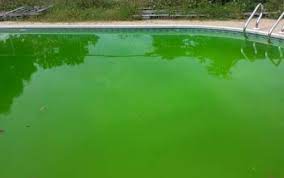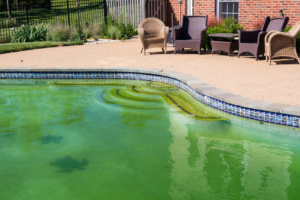A sparkling blue pool under the warm sun is an enticing sight, beckoning us to take a refreshing plunge. But what if that pool appears more akin to a murky swamp, its water tinted an unsettling shade of green? A green pool, indicative of rampant algae growth, raises concerns about its safety for swimmers. Can you swim in a green pool without risking your health?
In this article, we delve into the risks associated with swimming in a green pool, exploring the risk and causes to ensure a safe and enjoyable swimming experience.
Table of Contents
ToggleCan You Swim In A Green Pool?
Swimming in a green pool is generally not recommended. A green pool is an indication of algae growth, which can pose various health risks and make the water unsafe for swimming. Algae can cause skin and eye irritation, and some types of algae may even produce toxins that can be harmful if ingested.
The green color in a pool is usually a result of an imbalance in the pool’s water chemistry, particularly the presence of high levels of algae. This imbalance can occur due to insufficient chlorine levels, poor circulation, inadequate filtration, or improper maintenance.
If you encounter a green pool, it’s best to avoid swimming in it until the water is properly treated and restored to a clear and safe condition. Treating a green pool typically involves adjusting the water chemistry, shocking the pool with chlorine, and implementing proper filtration and circulation to eliminate the algae. It’s advisable to consult a pool professional or follow appropriate guidelines to restore the pool to a safe and swimmable state.
What are the causes, if a pool to turn green?
Insufficient Chlorine Levels:
One of the primary causes of a pool turning green is inadequate levels of chlorine. Chlorine helps to sanitize the water and prevent the growth of algae and bacteria. If the chlorine levels are too low, it creates an environment conducive to algae growth, leading to a green pool.
1.Algae Growth:
Algae are microscopic organisms that thrive in water environments. When the pool’s chlorine levels drop, or there is poor circulation and filtration, algae can quickly multiply and spread throughout the pool. This growth results in the water turning green as the algae reproduce and form colonies.
2.Poor Circulation and Filtration
Proper water circulation and filtration play a crucial role in maintaining a clean and clear pool. Insufficient circulation allows algae and other contaminants to settle and accumulate, contributing to the green coloration. Inadequate filtration fails to remove these particles effectively, promoting algae growth and discoloration.
3.Neglected Pool Maintenance
Irregular pool maintenance or neglecting basic care routines can also lead to a green pool. Lack of routine cleaning, brushing, and vacuuming can create an environment where algae thrive. Additionally, failing to balance the pool’s pH and total alkalinity levels can contribute to the growth of algae and the subsequent discoloration of the water.
4.Environmental Factors
Environmental factors, such as excessive sunlight and high temperatures, can accelerate the growth of algae in a pool. Warm and sunny conditions provide favorable conditions for algae to proliferate, even in well-maintained pools. Rainwater, wind-blown debris, and organic matter entering the pool can also introduce algae spores, exacerbating the green pool problem.
Note: It’s important to address these causes promptly and take appropriate measures to restore the pool’s water clarity and prevent future occurrences of a green pool.

Why is Swimming in a Green Pool Potentially Risky?
Swimming in a green pool can be potentially risky due to several reasons:
Skin and Eye Irritation: The presence of algae in a green pool can cause skin and eye irritation. Algae produce substances that can trigger allergic reactions or sensitivities in some individuals. Skin may become itchy, red, or develop rashes, while eyes can become red, watery, and irritated.
Slips and Falls: Algae growth in a pool can make surfaces slippery and increase the risk of slips and falls. Algae create a slimy layer on pool surfaces, including steps, ladders, and pool decks, making them hazardous and potentially causing accidents.
Respiratory Issues: Certain types of algae, such as blue-green algae or cyanobacteria, can release toxins into the water. When swimmers come into contact with or ingest water contaminated with these toxins, it can lead to respiratory issues such as coughing, wheezing, or even more severe respiratory distress.
Waterborne Illnesses: Algae in a green pool can serve as a breeding ground for harmful bacteria, including E. coli and other pathogens. These bacteria can enter the water through fecal contamination or other means. Swallowing or coming into contact with contaminated water can lead to gastrointestinal illnesses, such as diarrhea and stomach cramps.
Reduced Visibility: Green pool water has poor visibility due to the algae growth, making it challenging to see underwater obstacles or potential hazards. This can increase the risk of accidental collisions, injuries, or other accidents while swimming.
Algae-Related Infections: Some algae species can cause infections in open wounds or cuts if they come into contact with the contaminated water. These infections can be difficult to treat and may require medical attention.
It is important to prioritize the safety and well-being of swimmers by avoiding swimming in a green pool until the water is properly treated and restored to a clear and safe condition. Addressing the underlying causes of the green pool and implementing necessary precautions is essential to mitigate the associated risks.
How we can Restore Water clarity and Safety in a Green pool?
Restoring water clarity and safety in a green pool involves several steps and precautions. Here are the key measures to take:
1. Assess the Pool’s Water Quality:
Test the water’s chlorine and pH levels using a pool water testing kit. This helps determine the extent of the imbalance and guides subsequent treatment.
2. Shock the Pool with Chlorine:
To eliminate algae, shock the pool with a high dose of chlorine. Follow the manufacturer’s instructions and guidelines for proper shock treatment. This process raises the chlorine levels significantly to kill the algae.
3. Enhance Filtration and Circulation:
Ensure the pool’s filtration system is clean and functioning properly. Clean or backwash the filter to remove any debris or algae particles. Run the filtration system for an extended period to improve water circulation and remove suspended algae.
4. Brush and Vacuum the Pool:
Scrub the pool’s surfaces, including walls, floors, and steps, with a pool brush to dislodge and remove algae clinging to these areas. Use a pool vacuum to eliminate debris and algae residues from the pool floor.
5. Monitor and Adjust Chlorine Levels:
Regularly test and adjust chlorine levels to maintain proper disinfection and prevent future algae growth. Maintain the chlorine within the recommended range to keep the pool sanitized and algae-free.
6. Clean Pool Equipment and Accessories:
Clean or replace pool equipment, such as skimmer baskets and pump filters, to ensure optimal performance and prevent debris buildup that can contribute to algae growth.
7. Regular Pool Maintenance:
Implement a regular maintenance routine for the pool, including brushing, skimming, and vacuuming, to prevent the recurrence of algae growth. Ensure proper water balance by monitoring pH, alkalinity, and calcium hardness levels.
8. Preventive Measures:
Take preventive measures to minimize the risk of future algae growth. This includes regular monitoring of chlorine levels, maintaining proper water balance, maintaining proper circulation, and ensuring sufficient pool cover or shade to reduce sunlight exposure.
Note: If the green pool situation persists or if you are uncertain about the appropriate steps to take, it is advisable to seek assistance from a professional pool service provider who can assess and treat the pool accordingly.
Conclusion:
In conclusion, the question of whether you can swim in a green pool comes with risks and considerations. While it may be tempting to take a plunge, the presence of algae in a pool poses potential hazards to swimmers. Swimming in a green pool can lead to skin and eye irritation, increased risk of slips and falls, respiratory issues, waterborne illnesses, and reduced visibility. Therefore, it is crucial to prioritize the safety and well-being of swimmers.
Read More Guides


